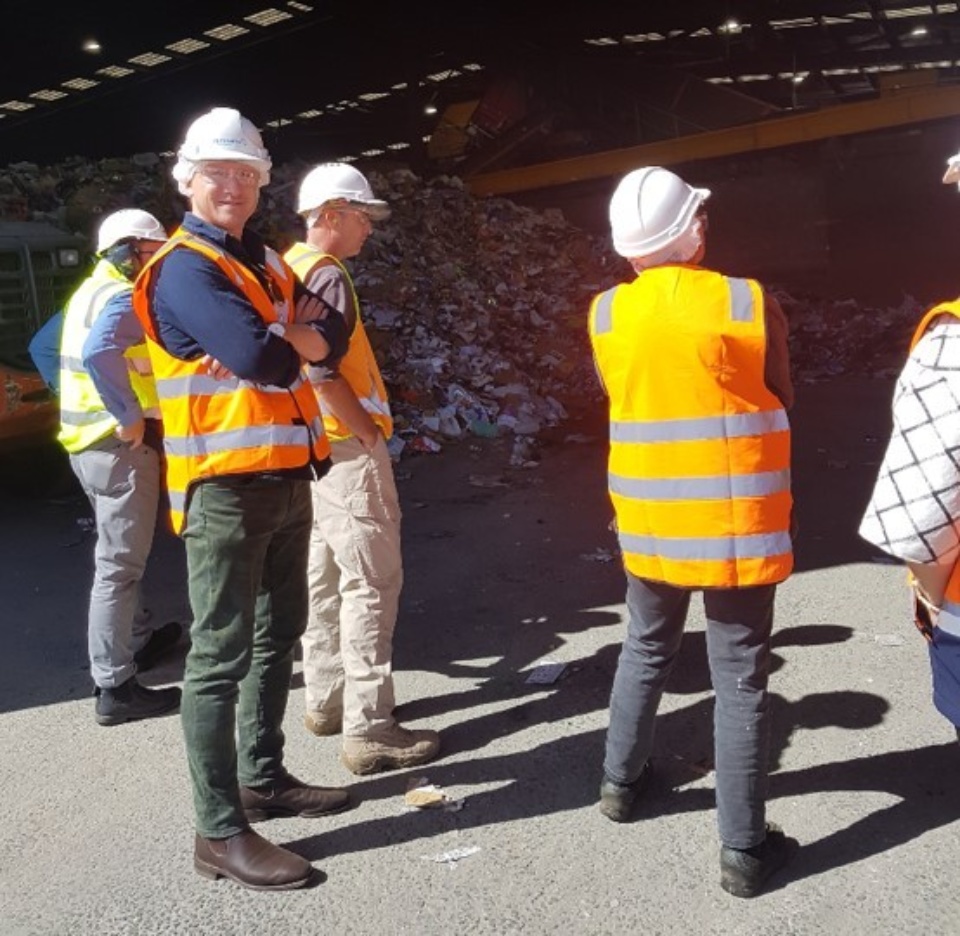
Glenorchy City Council works closely with our contractors to make sure the efforts our residents put into recycling correctly are not ‘wasted’. Read on to learn more about kerbside recycling and what happens to it after you put your recycling bin out to be collected.
COLLECTED AND SORTED
Council pays Veolia Environmental Services to empty our recycling bins and take the recyclables to the Materials Recovery Facility (MRF) in Derwent Park. Cleanaway Waste Management Ltd runs the MRF and is the contractor for all southern Councils. Cleanaway are paid by Councils to accept co-mingled (mixed up) recycling.
Once at the MRF, a series of conveyor belts takes the co-mingled recycling past sorting staff who manually remove contamination*, then specialised sorting machines which shake, rotate, sort and screen the material, and finally past more staff who separate different recyclables into ‘single stream’ items of similar products.
*Contamination is anything that could be dangerous to staff or machinery, or doesn’t go into the kerbside recycling bins, for example clothing, batteries, oil, paint and gas containers, cookware, clothing or flares. These items are recycled elsewhere, click here for more information on how to recycle these items. Contamination is also anything in plastic bags, which gets tangled and damage the machinery.
BALED AND SOLD
Sorted materials are baled and sent to local, mainland or export markets as ‘raw ingredients’ or ‘inputs’ to be turned into new products. The sale of recyclables is a commodities market, which is a marketplace for buying, selling, and trading raw or primary products.
Cleanaway, as a seller, negotiate both long-term and short-term contracts with buyers. The details of these contracts (like any contract between two businesses) are legally binding and private. However Council request information from Cleanaway on a regular basis, and are supplied with updated information on destinations for the baled materials.
FINAL DESTINATION
Below is a list of the items recycled by Glenorchy residents, sorted and baled by Cleanaway and then sold to businesses to process and turn back into products or packaging.
Paper/Newsprint:
Is pulped, screened and turned back into paper, paperboard and cardboard products. Currently this is sent to a recycler in Spreyton, Tasmania.
Cardboard:
Is pulped, screened and turned back into cardboard packaging. It can be sent to Cleanaway Victoria to on-sell, or directly exported from Hobart to a South East Asian manufacturer.
Glass:
Bottles and jars are sorted at the MRF then collected by a Tasmanian construction company to be used in roadworks. Council is currently trialing both Reconophalt and Glassphalt streetscaping, with our works team collaborating with local contractors to obtain the recycled product locally to go into the asphalt mix.
Tin Plate (Steel cans):
Steel cans have a layer of tin to stop rust and must be sent to specialised re-processers to separate the two metals. Almost two thirds of all new steel manufactured comes from recycled steel, everything from building materials, cars, railway tracks even into steel cans again. Currently Cleanaway’s steel can bales are sent to a recycler in Victoria.
Aluminium cans:
Aluminium is a very stable metal which can be smelted and recycled countless times - to make a can out of recycled aluminium takes 90% less energy than to make it from virgin aluminium. Currently Cleanaway sends their aluminium cans to a recycler in Victoria.
Plastic bottles and containers:
There are many different types of plastics and often containers will be marked with a recycling triangle symbol with a number inside it – this is the resin used to make the plastic and is normally a number between 1 and 7. Our kerbside recycling program takes rinsed, plastic containers 1,2,3,4,5, with lids on.
The recycling market for plastics varies a lot and Tenders (buying contracts) can often be done monthly. Below are some examples of current plastic types and destinations as at March 2021.
For plastic recycling to be done properly, the right facilities must exist. This means factories need to have ‘economies of scale’ by getting enough raw ingredients (in this case plastic), plus be able to sell enough of the products they make to stay in business. Very few of these factories exist in Australia and none in Tasmania, but the Federal Government is investing in a Recycling Modernisation Fund to support the building of new infrastructure that will help Australia process its own recycling.
PET (No. 1 in the recycling triangle):
Many drink bottles are PET, and most are turned back into polyester or polyester blends for clothing or textiles for household and automotive use. Currently the manufacturing for this is done in South East Asia.
Clear HDPE (number 2 plastic):
Clear or light-coloured plastic is very useful as it can be dyed easily, and HDPE is a very common type of plastic for milk bottles and other supermarket products. Processors recycle this plastic by washing, removing labels, shredding and melting, after which is can be molded back into almost any HDPE product. Currently the most efficient and biggest markets to get this done is in South East Asia.
Mixed plastics:
After a successful trial, Cleanaway is working with an industrial business in Victoria with state-of-the-art technology that identifies and sorts different types of plastics, and is the largest polymer (plastic resin) identification and flake manufacturer plant in Australia.
We’d like to remind everyone to look for and buy recycled products wherever they can, as this is will help ‘close the loop’ for recyclables and help Australia be more sustainable.
Please Note: All information above is correct and current at 9 March 2021, however may change due to circumstances beyond the control of Council.
📷 Alderman Simon Fraser and Glenorchy's Waste-wise volunteers examining the loading bay at our local Materials Recovery Facility. The pile of recyclables in the background represents approximately half of what Cleanaway receive from southern Tasmanian councils every day.